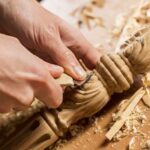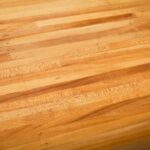Wood selection plays a crucial role in woodworking projects, as different types of wood offer unique characteristics and properties that can greatly impact the outcome of a project. One type of wood that is often considered for woodworking is bay tree wood. In this article, we will explore whether bay tree wood is good for woodworking and provide insightful information to help you make an informed decision when selecting wood for your projects.
When it comes to woodworking, choosing the right wood is essential. The type of wood chosen can affect the durability, workability, appearance, and overall success of your project.
Bay tree wood is one option that many craftsmen consider due to its distinct features and potential benefits. In the following sections, we will delve into the details of bay tree wood – its characteristics, pros and cons, properties, suitable projects, preparation steps, tips for working with it, finishing techniques, and sustainable sourcing practices.
Whether you are a seasoned craftsman or a beginner looking to start your woodworking journey, understanding the suitability of bay tree wood for your projects is crucial. By examining its various aspects and comparing it to other popular woods used in woodworking, you can make an educated decision about whether bay tree wood aligns with your needs and preferences. So without further ado,” let’s explore the world of bay tree wood”.
What is Bay Tree Wood
Bay tree wood, also known as bay laurel wood, is a popular choice for many woodworking projects. It comes from the bay tree, which is scientifically called Laurus nobilis. Bay trees are evergreen shrubs or small trees that are native to the Mediterranean region. They are often cultivated for their aromatic leaves, which are commonly used in cooking.
Characteristics of Bay Tree Wood:
One of the key characteristics of bay tree wood is its durability. It is a hardwood that is known for its ability to withstand wear and tear over time. This makes it ideal for furniture-making and other projects that require long-lasting materials. Additionally, bay tree wood has an attractive grain pattern and a medium to fine texture, which adds an aesthetic appeal to finished woodworking pieces.
Another important characteristic of bay tree wood is its workability. It is relatively easy to work with and responds well to hand tools and machinery. This makes it suitable for both beginner and experienced woodworkers alike. Moreover, bay tree wood has good stability and dimensional stability when properly dried and seasoned.
Sources of Bay Tree Wood:
Bay tree wood can be obtained from various sources. One option is purchasing pre-cut lumber or boards from specialized woodworking suppliers or online retailers. These suppliers often provide kiln-dried or air-dried bay tree wood in different sizes and dimensions.
Another source of bay tree wood is harvesting it yourself if you have access to a bay laurel tree or know someone who does. However, it’s important to ensure that this is done responsibly and sustainably by obtaining necessary permits or permissions when needed.
Pros and Cons of Bay Tree Wood for Woodworking
Bay tree wood can be a great option for woodworking projects, but it is important to consider its pros and cons before making a decision. Here are some advantages and disadvantages of using bay tree wood in woodworking:
Pros:
- Durability: Bay tree wood is known for its strength and durability, making it suitable for long-lasting woodworking projects. It can withstand heavy use and resist warping or shrinking over time.
- Workability: This type of wood is relatively easy to work with, making it suitable for both beginners and experienced woodworkers. It can be easily cut, shaped, and carved to create intricate designs.
- Appearance: Bay tree wood has a beautiful natural luster, with shades ranging from light yellow to reddish-brown. It often features a straight grain pattern with occasional dark streaks, adding visual interest to finished woodworking pieces.
Cons:
- Availability: Bay tree wood may not be readily available in all areas, as it typically comes from specific regions where bay trees grow abundantly. This limited availability can make it more expensive or harder to find compared to more common types of wood.
- Moisture Content: Bay tree wood has a tendency to retain moisture, which means it can take longer to dry properly before being used in woodworking projects. Improperly dried wood may lead to issues such as warping or cracking over time.
- Allergies: Some individuals may have allergic reactions when working with bay tree wood due to its natural oils and resins. Proper safety precautions, such as wearing protective gloves and masks, should be taken while handling this type of wood.
Overall, if you are able to access bay tree wood and take proper precautions during the woodworking process, it can be an excellent choice for your projects. Its durability, workability, and attractive appearance make it suitable for various applications such as furniture-making or cabinetry.
However, if you have limited access to bay tree wood or if you have specific allergies, it may be worth considering alternative wood options that can provide similar properties. Ultimately, the choice of wood should depend on your specific woodworking needs and preferences.
Bay Tree Wood Properties
When considering wood for woodworking projects, it is important to have a comprehensive understanding of the physical properties of the material. This includes characteristics such as density, grain texture, moisture content, and stability. In this section, we will delve into these properties of bay tree wood to help you determine if it is suitable for your woodworking needs.
- Density: Bay tree wood is known for its medium to high density. It typically falls within the range of 650-850 kg/m³ (40-53 lb/ft³), making it a relatively dense wood compared to some other species commonly used in woodworking. The density of bay tree wood contributes to its strength and durability, making it a viable option for various woodworking projects.
- Grain Texture: The grain texture of bay tree wood is generally fine and even, which lends itself well to fine woodworking and intricate detailing. The straight or slightly interlocking grain pattern adds visual interest and can result in beautiful finished pieces. The fine texture also makes bay tree wood relatively easy to work with using both hand tools and machinery.
- Moisture Content: Proper moisture content is crucial when working with wood to ensure structural integrity and prevent warping or cracking. Bay tree wood typically has a moisture content ranging from 8% to 14%. It is important to note that freshly cut bay tree wood may have a higher moisture content and requires drying before use in woodworking projects.
- Stability: The stability of bay tree wood refers to its ability to resist shrinking or expanding significantly due to changes in humidity or temperature. Overall, bay tree wood exhibits good stability when properly seasoned and dried. However, like most woods, it will still undergo slight dimensional changes under extreme conditions.
To summarize, bay tree wood has desirable properties for woodworking projects due to its medium to high density, fine grain texture, moderate moisture content, and good stability when properly prepared. These qualities make it suitable for various types of woodworking, including furniture-making, cabinetry, and carving. However, it is important to ensure that the wood has been ethically and sustainably sourced before proceeding with any woodworking project.
| Property | Value |
|---|---|
| Density | 650-850 kg/m³ (40-53 lb/ft³) |
| Grain Texture | Fine and even |
| Moisture Content | 8%-14% |
| Stability | Good when properly seasoned and dried |
Woodworking Projects Suitable for Bay Tree Wood
Bay tree wood is a versatile material that can be used in a variety of woodworking projects. Its unique properties make it particularly well-suited for certain applications. Whether you are interested in carving, furniture-making, cabinetry, or other popular woodworking projects, bay tree wood may be a great choice for your next venture.
One of the main advantages of using bay tree wood in woodworking projects is its workability. The wood is relatively soft and easy to shape, making it ideal for intricate carvings and detailed designs. This makes bay tree wood a popular choice among artisans and craftsmen who specialize in carving decorative objects or wooden sculptures. The fine grain texture of bay tree wood also adds to its appeal when used in carving projects, providing a smooth and polished finish.
Additionally, bay tree wood can also be used for furniture-making. Its durability and stability make it suitable for creating sturdy and long-lasting pieces of furniture. Whether you are crafting chairs, tables, cabinets, or shelves, bay tree wood can withstand regular use and maintain its structural integrity over time. The warm color and attractive grain patterns of bay tree wood also contribute to the aesthetic appeal of furniture pieces made from this material.
In cabinetry, bay tree wood offers both functionality and visual appeal. Its strength allows it to withstand heavy loads without warping or bending, making it an excellent choice for constructing durable cabinets that will stand the test of time. Bay tree wood’s natural beauty also adds character to cabinetry projects, providing a warm and inviting feel to any space.
In summary, bay tree wood is well-suited for various woodworking projects due to its workability, durability, and visual appeal. From intricate carvings to furniture-making and cabinetry, this versatile material offers both aesthetic value and functional performance. Consider incorporating bay tree wood into your next woodworking project to create unique and beautiful pieces that will last for years to come.
| Woodworking Project | Suitability |
|---|---|
| Carving | Excellent – Easy to shape and carve, fine grain texture for detailed designs |
| Furniture-making | Great – Durable and stable, attractive grain patterns for aesthetic appeal |
| Cabinetry | Highly suitable – Strong and resistant to warping, provides a warm and inviting feel to any space. |
Steps to Prepare Bay Tree Wood for Woodworking
Seasoning Bay Tree Wood
Before using bay tree wood in woodworking projects, it is important to properly season the wood. Seasoning helps to reduce the moisture content and stabilize the wood, ensuring that it will not warp or shrink over time. The process of seasoning involves allowing the wood to dry slowly and evenly.
One method for seasoning bay tree wood is air-drying. To air-dry the wood, it should be cut into smaller pieces or boards and stacked with spacers in between them to allow for air circulation. The stacks should be placed in a dry, well-ventilated area, protected from direct sunlight and rain.
It is important to regularly check the moisture content of the wood with a moisture meter during the drying process. Depending on the thickness of the wood and environmental conditions, it may take several months or even years for the wood to reach an optimal moisture level of around 8-12%.
Another method for seasoning bay tree wood is kiln-drying. Kiln-drying is a faster process that involves placing the wood in a specialized oven-like structure called a kiln. The kiln regulates temperature and humidity levels to quickly remove moisture from the wood without causing damage or excessive shrinking. Kiln-dried bay tree wood is ready for use in woodworking projects much sooner than air-dried wood.
Treating Bay Tree Wood
After seasoning, bay tree wood may require additional treatments or techniques depending on its intended use in woodworking projects. Some bay tree woods may have natural oils or resins present, which can affect its workability and finish quality.
To remove any oils or resins that could interfere with adhesion or finishing, it may be necessary to wipe down the surface of the wood with denatured alcohol or mineral spirits before applying any finish. This step will ensure that finishes adhere properly and provide long-lasting protection.
Additionally, certain woodworking projects may require specific treatments to enhance the durability and longevity of the bay tree wood. For instance, if using bay tree wood outdoors or in high-moisture environments, it is recommended to apply a waterproofing sealer or a protective coating to prevent water damage and decay.
Drying Bay Tree Wood
Once the bay tree wood has been seasoned and treated, it should be stored in a dry area with controlled humidity levels to prevent reabsorption of moisture. Properly dried wood will have a lower risk of warping, cracking, or splitting.
It is important to note that bay tree wood can continue to release moisture and change its dimensions even after it has been properly dried. Therefore, it is advisable to acclimate the wood to the environment where it will be used before beginning any woodworking project. This can be done by letting the wood sit for a few days in the environment where it will be installed or used.
By following these steps for preparing bay tree wood for woodworking projects, you can ensure that the wood is stable, workable, and ready for use. Proper seasoning, treating, and drying techniques contribute to the overall quality and longevity of your woodworking creations.
Tips for Working with Bay Tree Wood
When working with bay tree wood, there are several expert tips and tricks that can help ensure a successful woodworking project. Here are some recommendations for the best tools and techniques, as well as common challenges to overcome when working with bay tree wood:
- Tools: The right tools can make a significant difference when working with bay tree wood. It is recommended to use sharp chisels, gouges, and carving knives for intricate carving work. For cutting and shaping larger pieces, a high-quality band saw or table saw is recommended. It is also important to have a good set of sandpaper in various grits for smoothing and finishing the wood.
- Techniques: Bay tree wood can be relatively hard and dense, so it is essential to take your time and work slowly and carefully when shaping or carving it. Start with rough shaping using larger tools, then gradually move on to finer details with smaller tools. It is also advisable to frequently check the moisture content of the wood to prevent cracking or warping during the drying process.
- Challenges: One common challenge when working with bay tree wood is its tendency to splinter or chip easily, especially when cutting across the grain. To minimize this risk, it is recommended to use sharp tools and make sure to cut slowly and steadily.
Another challenge is its natural oils that can sometimes cause issues with gluing or finishing the wood. To overcome this challenge, it is important to clean the surface thoroughly before applying any glue or finish.
By following these tips and tricks, you will be able to effectively work with bay tree wood in your woodworking projects while achieving excellent results. Remember to always prioritize safety by wearing protective gear such as goggles and gloves when using power tools or handling sharp objects.
- Use sharp chisels, gouges, and carving knives for intricate carving work.
- Utilize a high-quality band saw or table saw for cutting and shaping larger pieces.
- Keep a variety of sandpaper grits on hand for smoothing and finishing the wood.
- Work slowly and carefully when shaping or carving bay tree wood due to its hardness and density.
- Start with rough shaping using larger tools, then gradually move on to finer details with smaller tools.
While working with bay tree wood, it’s important to be mindful of some common challenges that may arise:
- Splintering or chipping: Bay tree wood can be prone to splintering or chipping, especially when cutting across the grain. To minimize this risk, use sharp tools and cut slowly and steadily.
- Natural oils: Bay tree wood naturally contains oils that can interfere with gluing or finishing. Ensure that you clean the surface thoroughly before applying any glue or finish to mitigate this issue.
By keeping these tips and challenges in mind, you can overcome any potential obstacles and create beautiful woodworking projects using bay tree wood.
Finishing Bay Tree Wood
Finishing Bay Tree Wood:
When it comes to working with bay tree wood in woodworking projects, the finishing process plays a crucial role in enhancing its appearance and protecting it from wear and tear. There are several different methods for finishing bay tree wood, each with its own unique benefits and considerations.
One popular option for finishing bay tree wood is to use a sealer. Sealers provide a protective layer that helps to prevent moisture damage and minimize staining. They also enhance the natural beauty of the wood by bringing out its color and grain patterns. It is important to choose a sealer that is specifically designed for use with bay tree wood, as some sealers may not be compatible or may alter the appearance of the wood.
Another option for finishing bay tree wood is to use oils. Oils penetrate the wood fibers, nourishing them and bringing out their natural luster. This can create a beautiful, smooth finish that showcases the unique characteristics of the bay tree wood. However, it is important to note that using oils may require more frequent maintenance compared to other finishes, as they may need to be reapplied periodically.
Stains are also commonly used to finish bay tree wood. Stains provide color while still allowing the natural grain of the wood to show through. They can be used to achieve a wide range of finishes, from light and natural-looking to rich and dark tones. When choosing a stain for bay tree wood, it is important to consider its compatibility with the specific type of wood being used, as well as any desired effects or color preferences.
Lastly, varnishes can be used to finish bay tree wood, providing a protective layer that resists scratches and other forms of wear. Varnishes come in various sheens, ranging from matte to high-gloss finishes. They not only protect the surface of the wood but also enhance its overall appearance by adding depth and richness.
Sustainable Sourcing of Bay Tree Wood
As woodworking continues to gain popularity, it is becoming increasingly important to consider the environmental impact of our material choices. This includes the responsible sourcing of wood for our projects. When it comes to bay tree wood, sustainability is a crucial factor to keep in mind.
Bay tree wood comes from the bay laurel tree, also known as Laurus nobilis. This tree species is native to the Mediterranean region and can also be found in other parts of the world such as California and North Africa. In order to ensure sustainable sourcing of bay tree wood, it is important to look for suppliers who practice responsible forestry management.
Responsible wood sourcing involves various practices that prioritize the long-term health and well-being of forests. It includes measures such as replanting trees after harvesting, protecting biodiversity, and promoting responsible harvesting techniques that minimize damage to surrounding ecosystems. By choosing suppliers who adhere to these principles, we can contribute to the preservation of natural resources and reduce our environmental impact.
Conclusion
In conclusion, bay tree wood is a viable option for woodworking projects, but it does come with its pros and cons. On the positive side, bay tree wood is known for its durability and workability, making it suitable for a variety of applications such as carving, furniture-making, and cabinetry. Its unique appearance adds a touch of natural beauty to any project. However, it’s important to consider that bay tree wood can be challenging to source sustainably.
When working with bay tree wood, it is crucial to properly prepare the wood before starting any project. This involves seasoning and drying the wood to ensure stability and minimize the risk of warping or splitting. Additionally, using the right tools and techniques will greatly enhance your woodworking experience with bay tree wood.
For those considering using bay tree wood in their woodworking projects, it is essential to understand that responsible sourcing is critical. Ensuring that the bay tree wood used comes from ethical and sustainable sources protects our environment and helps preserve these valuable resources for future generations.
Frequently Asked Questions
What is bay tree wood good for?
Bay tree wood, also known as bay laurel wood, is highly valued for its fine-grained nature and attractive appearance. It is commonly used in the furniture industry for crafting high-quality cabinets, veneers, and decorative items.
The wood’s stability makes it suitable for intricate carving work, while its natural resistance to decay ensures its longevity. Additionally, bay tree wood has a pleasant aroma that adds to its appeal, making it a popular choice for crafting musical instruments such as guitars or flutes.
Do bay trees make good firewood?
While bay trees do produce usable firewood, they are not considered the best option for this purpose. Bay tree wood burns relatively slowly and may produce a low heat output compared to hardwoods like oak or maple.
It tends to smolder rather than create a vigorous flame, resulting in less efficient combustion and potential difficulties in achieving a steady fire. However, if you have access to abundant bay tree wood or simply prefer using it due to its availability, it can still serve as an adequate source of firewood.
Is a bay leaf tree hardwood?
A bay leaf tree does not fall under the category of hardwood trees but is instead classified as an evergreen broadleaf tree belonging to the lauraceae family. Hardwood trees generally refer to deciduous trees with dense and durable wood such as oak or mahogany.
In contrast, bay leaves come from the Laurus nobilis species, which features softer wood that is more akin to other evergreen trees like cedar or pine. Despite not being classified as a hardwood, bay leaf trees can still be utilized for various purposes due to their desirable properties such as their aromatic leaves or finely grained timber suitable for specialized woodworking projects

Hi everyone! I’m a woodworker and blogger, and this is my woodworking blog. In my blog, I share tips and tricks for woodworkers of all skill levels, as well as project ideas that you can try yourself.





